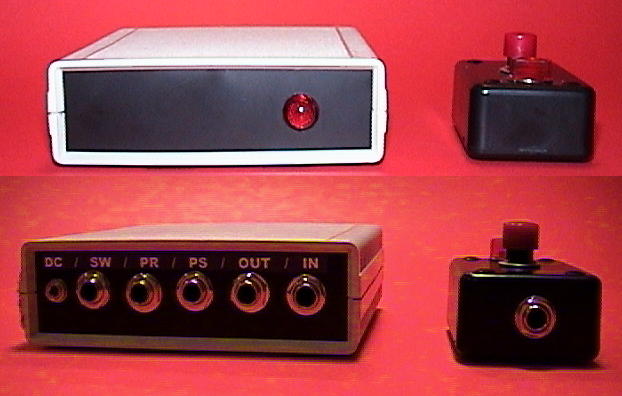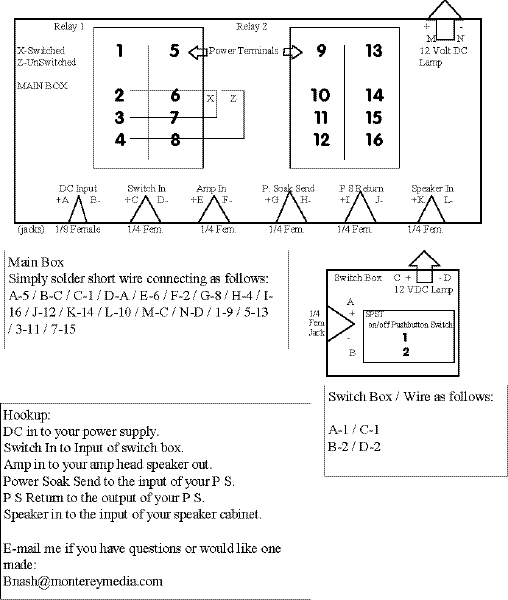Home (amp tone and effects placement)
Power Soak Bypass Box


Contributed to Amptone.com by Bill Nash as a DIY project. This is important for a true multichannel switching amp that includes switching of the overall volume in conjunction with controlling the amount of power-tube saturation. The Power Soak Bypass Box enables you to have a clean channel that's full volume but with little power-tube saturation, and a dirty channel that has full power-tube saturation but with arbitrarily low volume in the room.
The minimal layout of a multichannel amp has two preamp gain controls and one final volume control. The final volume control adjusts the overall volume *and* the amount of power-tube saturation, without being able to control these factors independently (to get lots of power-tube saturation with little volume). The conventional full-featured multichannel amp layout has a preamp gain control and final volume control for channel 1, and a separate preamp gain control and final volume control for channel 2. Still, you can't set any combination of preamp gain, power-tube saturation, and final volume in the room, on either channel.
This architecture has been largely integrated into an amp designed by Jim Kelley.
Jim Kelley FACS 112 with outboard attenuator
>You really have to hear and use one of these amps to get an idea of good they really are. The FACS amp was simply a two channel version of the single channel Kelley. Neither had a built in power attenuator, but both were designed to use the Kelley power attenuator. The FACS model was designed so that one could switch between attenuated and non-attenuated channels,each with its own set of Kelley-style tone controls. I've rarely seen these amps go for less than a grand in good condition, and when I have I've picked them up. These may be the best Fender sounding amps ever made, Fenders included.
Bill Nash (montereymedia.com, bnash) wrote:
I was less than satisfied with my Marshall JCM 900. The two channels situation was good but it never sounded as fat as my JCM 800, Fender Bassman or Showman. Still , I used it for all but recording as I needed those two separate volume settings (rhythm/lead). I asked my local amp guy about building a Power Soak bypass thus enabling me make any amp (especially a Master Volume enabled amp) act like a two channel setup. He scratched his head and gave me several reasons why he did not want to attempt this and I bagged the idea for another year.
The answer finally came recently while on the Stairmaster - use relay switches to do your dirty work! It took me three attempts several trips to Radio Shack and my hardware store, but I do feel I have the final product. My first attempt used 120 Volts AC as these were the first heavy duty relays I found, now it runs on 9-12 volts, just like any other stomp box setup. It is quite easy to put together. Here's the basic principal:
Use a remote footswitch (at pedal board?) to complete the 12 volt signal, sending it to the bypass box at the amp head. This box contains two (2) 12 volt DPDT relays. One routes your amp's pure signal to either straight to your speaker or through your Power Soak. The other relay completes this task by switching your speaker cabinet feed from either this altered (Power Soak) mode or full power.
Both the stomp box and switching boxes have 12 volt lights indicating full power mode. This can be run with a decent 9-12 volt adapter or a 9 volt battery, get one or change the one you have to a 1/8 inch male phono jack. Mine can go either way as I also have a battery pack/box (9 volt) with a 1/8 inch male out.
Parts
1 medium PLASTIC project box
1 small PLASTIC project box
2 - 12 Volt DPDT relay switches
2 - 12 Volt lamps (color & size are your call)
6 - 1/4 inch female mono jacks
1 - 1/8 female mono jack (or whatever will work with your 9-12 volt adapter - any decent 9 volt adapter w at least 400 m/a output should work. I am using one that came with a Morley Wah. Do not use a Radio Shack adapter, they are not reliable). [I've found that RS quality varies. - mh]
1 Push on / Push Of pushbutton (SPST).
A couple of feet of decent wire.
Several extra-short male/male speaker cables
1 long speaker or instrument cable to run from amp area to pedal area.
Drill holes in switch box for one 1/4 inch jack, switch and lamp, drill main box for one 1/8 inch jack, five 1/4 inch jacks (on back) and lamp (on front). Assemble and wire as per the following diagram and instructions. Make sure that your relay switches work as outlined, if not change the wiring to work as indicated.
I use Velcro to attach to the top of my amp.
I
hope you enjoy.
-- Bill
Amptone.com ultra gear-search page
Home (amp tone and effects placement)